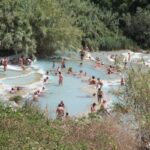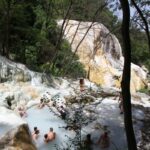Tuscany is the region of Italy with the highest density of thermal baths. Many settlements are scattered throughout the territory, they are sometimes located in the heart of ancient villages, sometimes of Roman origin. They are varied with their warm waters, each with its specificity, as the treatments of the skin with the mud therapy, the hydrotherapy, the hydromassage or the therapies of rehabilitation.
Many are landscaped and some are free access and sometimes in the middle of nature.
They are found from the Apuan Alps in the north to the coast of the Maremma in the south-west, passing through the Siena’ region.
Thermal sites
- In the foothills of the Ligurian Alps to the north, there are the thermal baths of Equi below, Bagni di Lucca with its many sources that hosted Elisa Bonaparte early 19th century.
- At the foot of Mount Pisano, to the east of Pisa, towards the Arno valley, are the San Giuliano thermal baths and the Uliveto thermal baths.
- Towards Pistoia, Montecatini is a famous thermal destination, and close to Monsummano with its underground waters of its humid caves and in particular the cave Giusti which is the largest thermal cavity in the world.
- In Impruneta are the thermal baths of nearby Florence, which date back to the Romans.
- In the hills further south between Pisa and Volterra, there are the thermal baths of Casciana (Casciana Terme).
- South of Siena, around Bagno Vignoni there are some beautiful thermal sites, including the warm and calcareous waters of Bagni San Filippo with its free-access pools. Also mention Bagni di Petriolo.
- In the Crete Senesi to the east of Siena, Rapolano has warm waters from several spas.
- Near Montepulciano, Chianciano Terme is a spa town with several springs.
- In the south of Tuscany, San Casciano Terme has 40 springs, near the border with Umbria and Lazio.
- To the southwest, the Saturnia thermal baths have beautiful waterfalls and white bathtubs that are free to access.
- To the west and the Maremma, there are the Venturina thermal baths.
- The Elba Island also has thermal baths in San Giovanni, with filtered sea water.
The free thermal baths
The «free» thermal baths are indeed free and open to all, but there is usually an access with schedules. In Tuscany, there are many free sites: Bagni San Filippo, Bagno Vignoni, Petriolo, San Casciano dei Bagni, and Saturnia.
- Bagni San Filippo, south of Pienza is on the foothills of Mount Amiata.
- Bagno Vignoni is located in the remarkable region of Val d’Orcia, with for example the large basin on the main square of San Quirico d’Orcia and the free thermal baths of Bagno Vignoni and its limestone waterfalls.
- The Petriolo thermal baths are located in the province of Siena near Monticiano.
- The Roman thermal baths of Caldane, 4 km from Colle Val d’Elsa
Mineral-warm basins, open to the open air. Ancient thermal baths have disappeared. - San Casciano dei Bagni is in the south of the region, close to Umbria.
- Near the Maremma to the west, the Terme di Saturnia, where small white limestone basins descend the hill and alternate with hot water cascades.
Where are the thermal baths in Tuscany
On the map, thermal spa ![]() and “free thermal baths”
and “free thermal baths” ![]()
If you see this after your page is loaded completely, leafletJS files are missing.
Others post about thermal baths in Tuscany
- Thermal baths of Saturnia
 The Thermal hot spring of Saturnia (Terme di Saturnia in Italian) are one of the most famous sites in Tuscany, with its natural hot water baths, formed by beautiful limestone ...
The Thermal hot spring of Saturnia (Terme di Saturnia in Italian) are one of the most famous sites in Tuscany, with its natural hot water baths, formed by beautiful limestone ... - Bagni San Filippo and Vivo d’Orcia
 Bagni San Filippo On the eastern slopes of Mount Amiata, bordering the Val d’Orcia, Bagni San Filippo is a thermal village whose waters have been known since antiquity. Its hot, therapeutic ...
Bagni San Filippo On the eastern slopes of Mount Amiata, bordering the Val d’Orcia, Bagni San Filippo is a thermal village whose waters have been known since antiquity. Its hot, therapeutic ...
Posts in Activities directory
- Discover the flavors of Tuscan winesDiscover the aromas and flavours of Tuscan vineyards Tuscany offers a variety of activities to discover why its wines are so popular: organized visits to estates, vineyards and wineries, tastings, sightseeing ...
- Via Francigena
 The Via Francigena is a pilgrimage route that was used in the Middle Ages to reach Rome from northern France. Its name means “french way”. The usual route corresponds to ...
The Via Francigena is a pilgrimage route that was used in the Middle Ages to reach Rome from northern France. Its name means “french way”. The usual route corresponds to ... - Visits to cellars and vineyardsSuggestions for wine country tours and activities in the Chianti and Tuscan wine routes, including tastings and cellar visits
No Comments Yet